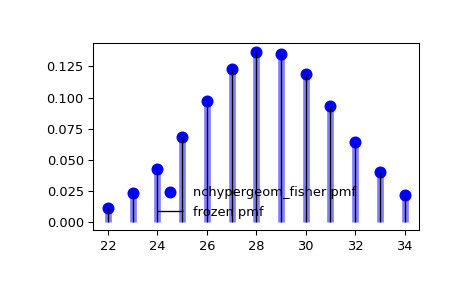本文簡要介紹 python 語言中 scipy.stats.nchypergeom_fisher 的用法。
用法:
scipy.stats.nchypergeom_fisher = <scipy.stats._discrete_distns.nchypergeom_fisher_gen object>#Fisher 的非中心超幾何離散隨機變量。
Fisher 的非中心超幾何分布模型從 bin 中繪製兩種類型的對象。 M 是對象的總數,n 是 I 類對象的數量,odds 是優勢比:當每種類型隻有一個對象時,選擇 I 類對象而不是 II 類對象的幾率。隨機變量表示如果我們一次從 bin 中取出少量對象,然後發現我們取出了 N 個對象,則抽取的類型 I 對象的數量。
作為
rv_discrete類的實例,nchypergeom_fisher對象從它繼承了一組通用方法(完整列表見下文),並用特定於此特定發行版的詳細信息來完成它們。注意:
讓數學符號,, 和對應參數N,n, 和M(分別)如上定義。
概率質量函數定義為
對於 , , , , , 其中 , ,
二項式係數定義為
nchypergeom_fisher使用 Agner Fog 的 BiasedUrn 包,並有權在 SciPy 的許可下分發它。用於表示形狀參數的符號 (N,n, 和M) 不被普遍接受;選擇它們是為了與scipy.stats.hypergeom.
請注意,Fisher 的非中心超幾何分布不同於 Wallenius 的非中心超幾何分布,後者對繪製預先確定的N一個箱子中的物品。然而,當優勢比為 1 時,兩種分布都歸結為普通的超幾何分布。
上麵的概率質量函數以“standardized” 形式定義。要轉移分布,請使用
loc參數。具體來說,nchypergeom_fisher.pmf(k, M, n, N, odds, loc)等同於nchypergeom_fisher.pmf(k - loc, M, n, N, odds)。參考:
[1]阿格納霧,“Biased Urn Theory”。https://cran.r-project.org/web/packages/BiasedUrn/vignettes/UrnTheory.pdf
[2]“Fisher 的非中心超幾何分布”,維基百科,https://en.wikipedia.org/wiki/Fisher’s_noncentral_hypergeometric_distribution
例子:
>>> import numpy as np >>> from scipy.stats import nchypergeom_fisher >>> import matplotlib.pyplot as plt >>> fig, ax = plt.subplots(1, 1)計算前四個時刻:
>>> M, n, N, odds = 140, 80, 60, 0.5 >>> mean, var, skew, kurt = nchypergeom_fisher.stats(M, n, N, odds, moments='mvsk')顯示概率質量函數(
pmf):>>> x = np.arange(nchypergeom_fisher.ppf(0.01, M, n, N, odds), ... nchypergeom_fisher.ppf(0.99, M, n, N, odds)) >>> ax.plot(x, nchypergeom_fisher.pmf(x, M, n, N, odds), 'bo', ms=8, label='nchypergeom_fisher pmf') >>> ax.vlines(x, 0, nchypergeom_fisher.pmf(x, M, n, N, odds), colors='b', lw=5, alpha=0.5)或者,可以調用分布對象(作為函數)來固定形狀和位置。這將返回一個 “frozen” RV 對象,其中包含固定的給定參數。
凍結分布並顯示凍結的
pmf:>>> rv = nchypergeom_fisher(M, n, N, odds) >>> ax.vlines(x, 0, rv.pmf(x), colors='k', linestyles='-', lw=1, ... label='frozen pmf') >>> ax.legend(loc='best', frameon=False) >>> plt.show()
檢查
cdf和ppf的準確性:>>> prob = nchypergeom_fisher.cdf(x, M, n, N, odds) >>> np.allclose(x, nchypergeom_fisher.ppf(prob, M, n, N, odds)) True生成隨機數:
>>> r = nchypergeom_fisher.rvs(M, n, N, odds, size=1000)
相關用法
- Python SciPy stats.nchypergeom_wallenius用法及代碼示例
- Python SciPy stats.nct用法及代碼示例
- Python SciPy stats.ncf用法及代碼示例
- Python SciPy stats.ncx2用法及代碼示例
- Python SciPy stats.norminvgauss用法及代碼示例
- Python SciPy stats.normaltest用法及代碼示例
- Python SciPy stats.nbinom用法及代碼示例
- Python SciPy stats.nakagami用法及代碼示例
- Python SciPy stats.norm用法及代碼示例
- Python SciPy stats.nhypergeom用法及代碼示例
- Python SciPy stats.anderson用法及代碼示例
- Python SciPy stats.iqr用法及代碼示例
- Python SciPy stats.genpareto用法及代碼示例
- Python SciPy stats.skewnorm用法及代碼示例
- Python SciPy stats.cosine用法及代碼示例
- Python SciPy stats.directional_stats用法及代碼示例
- Python SciPy stats.invwishart用法及代碼示例
- Python SciPy stats.bartlett用法及代碼示例
- Python SciPy stats.levy_stable用法及代碼示例
- Python SciPy stats.page_trend_test用法及代碼示例
- Python SciPy stats.itemfreq用法及代碼示例
- Python SciPy stats.exponpow用法及代碼示例
- Python SciPy stats.gumbel_l用法及代碼示例
- Python SciPy stats.chisquare用法及代碼示例
- Python SciPy stats.semicircular用法及代碼示例
注:本文由純淨天空篩選整理自scipy.org大神的英文原創作品 scipy.stats.nchypergeom_fisher。非經特殊聲明,原始代碼版權歸原作者所有,本譯文未經允許或授權,請勿轉載或複製。
